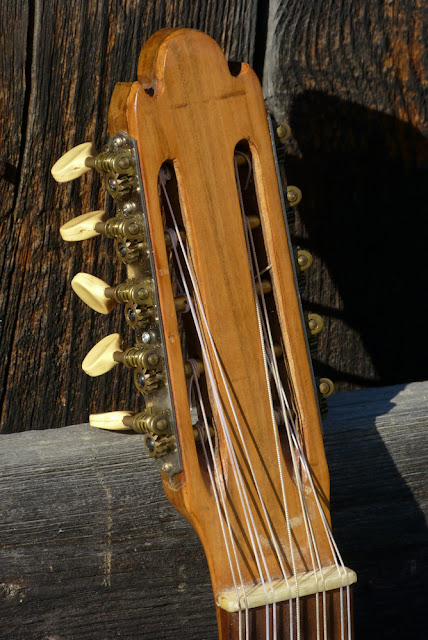1980s Bolivian-made Rambert Ferrufino Alba Ronroco
Chasing down information on charango or ronroco makers is pretty much the territory of wild geese, though judging by the case and build this probably dates from the late 70s through the early 80s. Fortunately, the instrument itself is more easily understood. The ronroco is, basically, a larger-bodied and slightly-longer-scale charango. In Bolivia these seem to be tuned down an octave (as is the case with this one) using wound nylon strings (a mix of nylon-wound-on-nylon and a bit of wire-on-nylon, here) but in other regions it seems there are various other tunings used.
Standard tuning is GCEAE (low to high, and re-entrant). When I played charango, I tuned mine in guitar-style intervals GCFAD so I could simply use guitar-shaped chords voiced a step down. That's what I did here (albeit a half-step up at G#) to record the soundclip as I get lost in the GCEAE tuning (despite its similarity to uke shapes). It has a big, lush sound that recalls a vihuela on steroids. Traditionally these are almost entirely "strumming" instruments, because of that sound, though fingerpicking gives the instrument a lute-like quality that's very charming.
This instrument has been hanging around in the workshop a long time. It came in relatively good shape, but needed the tuners turned-around and lubed (as well as a set of new plate-screws all around), the bridge hacked-up to allow a lower (and more precise) saddle at its front edge, a restringing, and a very, very light level and dress of the fret edges. The instrument (luckily) came with the Bolivian-style strings in the case.
The top is spruce and the back, sides, and neck are all cut from one piece of wood. The neck is then grafted to a separate piece for the headstock. It's an interesting, and typical, build for this type of instrument, though this one has held up quite well and that suggests better-than-average quality.
This has a 2" nut width and 18" scale length.
If you look closely you'll see a few filled-in lines on the fretboard from where the maker accidentally cut fret slots in the wrong place. Fair enough!
Intonation is pretty good, but as is often the case with these folksy instruments, not right on the dime.
The overlaid wooden scratchplate is typical of these instruments. The only "cracks" are in the veneer of this plate. Note also how nicely-worn the additional white pickguard is.
To get a new saddle in I had to hack the front of the bridge off. These are traditionally cut straight-through and the strings tied-off. Unfortunately that doesn't allow for action-height adjustments. I set this up with 1/16" action at the 12th fret for easy playability after this mod.
The strings also, now, run through tiny holes drilled through the top under the bridge (you push them through, pull them out the soundhole, and knot -- easier than it sounds). This is a sturdier mounting method and allows better break-angle on the saddle for cleaner tone.
The tuners were, interestingly, installed reverse to begin-with. After a lube and install in the other direction they're working just fine.
The heartwood color contrast looks awfully nice on that carved-from-one-block back/neck bit.
This one has nice wooden binding/purfling layers.
Built in Cochabamba. If anyone has any knowledge of this maker, please share.
A hard case comes with it (I know, shocking)!


















Comments
Is this still available? I'm interested in buying it!